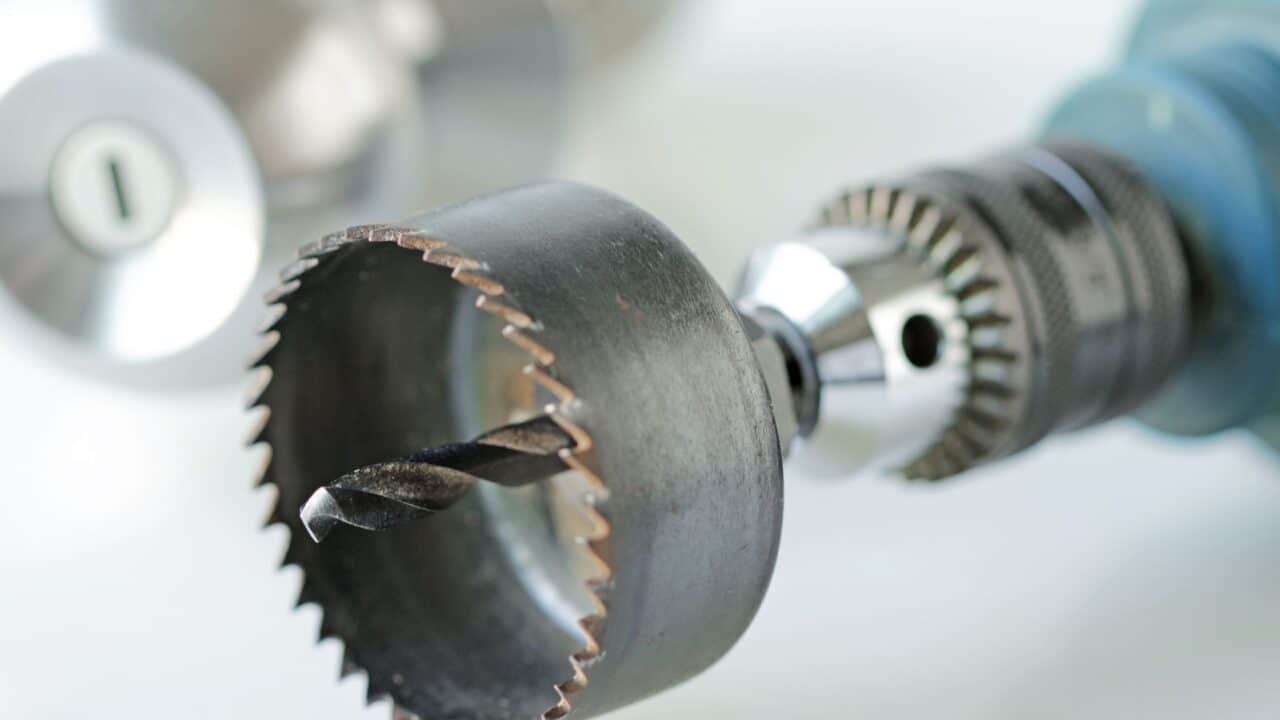To cut holes in a vanity for pipes without ruining it, measure twice, mark clearly, and use the right tools—a hole saw for round cuts or an oscillating tool/jigsaw for square ones. Whether your pipes come from the floor or wall, careful prep is key to avoiding splinters, cracks, or misaligned openings.
How to Cut Holes in a Vanity for Pipes Without Ruining It
Buying or building the perfect vanity is a great upgrade—until you realize your plumbing doesn’t line up with the factory cutouts (or there aren’t any at all). Maybe your pipes come up from the floor. Maybe they’re off-center or come out of the wall where the vanity has a full backing. Either way, you’ll need to customize the cabinet without destroying it.
This guide walks you through how to cut clean, accurate holes for drain pipes, water lines, and shut-off valves—no matter where they enter—and how to avoid common DIY mistakes that can crack or ruin your vanity.
Understand Where Your Pipes Are Coming From
Before you even think about making cuts, you need to understand your pipe layout. The two most common setups:
🔧 Pipes From the Wall
-
Usually about 18–21 inches off the floor
-
Drain is centered (but not always!)
-
Hot and cold water lines are typically spaced 8 inches apart
🔧 Pipes From the Floor
-
Often occur in older homes or slab foundations
-
Water lines may come up near the back wall, but the drain might be off-center
Take photos and measurements before buying or modifying your vanity. Knowing exactly where your pipes enter will tell you where and how big your holes need to be.
Tools You’ll Need
Here are the tools that make this job easier and cleaner:
| Tool | What It’s For | Link |
|---|---|---|
| Hole Saw Kit (1”–3”) | Clean, circular holes for supply lines or drains | Check on Amazon |
| Oscillating Multi-Tool | Great for square or odd-shaped cuts in tight spaces | Check on Harbor Freight |
| Jigsaw | Good for larger openings or full cutouts in the back | Check on Harbor Freight |
| Drill + Pilot Bit | Starts your hole saw or jigsaw cuts | Check on Harbor Freight |
| Painter’s Tape | Prevents chipping and marks clean lines | |
| Speed Square & Pencil | Marking precise hole locations |
Optional but helpful:
-
Wood chisel for small trim adjustments
-
Clamp-on work light if you’re working in a tight bathroom space
Step-by-Step: Cutting Holes in a Vanity
1. Mark Your Pipe Locations
Use a tape measure to map out where your pipes are located in the wall or floor. Then transfer those measurements to the vanity:
-
Flip the vanity over if your pipes come from the floor
-
Lay the vanity front-down to access the back panel if your pipes come from the wall
Use a pencil and speed square to mark the exact center points.
2. Protect the Finish
Apply painter’s tape over the areas you plan to cut. This:
-
Helps prevent the wood from splintering
-
Gives you a visible cutting line
Then re-mark your cut lines on top of the tape.
3. Drill Pilot Holes (If Using a Hole Saw or Jigsaw)
For hole saws:
-
Drill a small pilot hole at your center mark to guide the saw.
For jigsaws:
-
Drill a ½” starter hole inside your cut line to insert the blade.
4. Make the Cut
✅ For Round Holes (supply lines, drains):
Use the appropriate size hole saw based on your pipe diameter:
-
1 3/8” for standard water lines with shut-off valves
-
2–2½” for P-traps or drainpipes
Drill slowly and let the tool do the work. Applying too much pressure can splinter or crack the vanity board.
✅ For Square or Rectangular Cutouts:
Use an oscillating tool or jigsaw to carefully follow your tape line. This is especially helpful for:
-
Large back panel openings
-
Tight spaces where you can’t fit a drill
-
Custom cutouts for off-center pipes
Work slowly and double-check your fit often. You can always cut more—but you can’t un-cut.
What If I Made the Hole Too Big?
If your cut ends up a little too large, don’t panic.
Here’s how to cover mistakes cleanly:
-
Use escutcheon plates around the pipes for a clean, finished look
-
Plastic escutcheons are budget-friendly
-
Metal ones offer a more polished finish
-
-
If needed, add a thin wood backer inside the vanity to re-anchor shut-off valves
For gaping holes in visible areas, consider using a cabinet hole repair kit or patching with a wood filler and repainting.
Cutting Through the Bottom of a Vanity
If your drain comes up from the floor:
-
Remove drawers or shelves to give yourself clearance
-
Mark and cut from the underside of the vanity using a hole saw
-
Be cautious not to hit any braces or structural supports
It may help to assemble the vanity in the room, then cut it in place once you’ve dry-fit around the pipes.
Tips to Avoid Splitting or Ruining Your Vanity
-
Always use sharp blades and high-quality hole saws
-
Support the panel you’re cutting—don’t let it wobble
-
Avoid pressing too hard, especially near the edges of MDF or particle board
-
Don’t skip the painter’s tape
-
If the vanity is laminate-coated, cut from the back side to reduce chipping
Final Fit Tip: Dry-Fit First
Before installing the faucet or attaching the vanity to the wall, dry-fit everything:
-
Test pipe alignment through your holes
-
Make sure drawers and shelves still open
-
Check for clearance behind the cabinet
If it all lines up, you’re ready to anchor the vanity and hook up your plumbing!
FAQ
❓Can I use a spade bit instead of a hole saw?
You can, but it won’t give as clean a result—especially in MDF or laminated surfaces. Hole saws are safer and more precise.
❓What if my vanity has a full back panel?
You can either cut a U-shape to allow the pipes to slide in or cut a square/rectangular opening with a jigsaw or oscillating tool.
❓Should I cut before or after painting the vanity?
Always cut before painting or sealing. That way, you can clean up edges, sand lightly if needed, and then finish everything cleanly.
❓Do I need to seal the cut wood?
Yes—especially for bathroom use. Apply a light coat of polyurethane or primer around the cut area to prevent swelling from moisture.
❓What’s the easiest way to hide an uneven hole?
Use pipe flanges or escutcheon plates. They hide oversized or rough cuts and give the vanity a finished, professional appearance.
Need Help With a Vanity Install?
If you’re in Northeast Ohio, we’d love to help! Whether your vanity is custom, vintage, or brand new from the box store, Colin Can Help handles vanity installs the right way—with clean cuts, leak-proof plumbing, and a great fit every time.
👉 Contact us to schedule your vanity installation
Disclaimer: Some of the links in this article are affiliate links, which means we may earn a small commission if you make a purchase—at no extra cost to you. We only recommend tools and products we trust and use ourselves.

